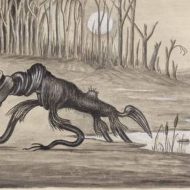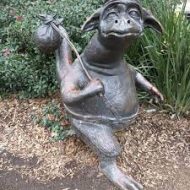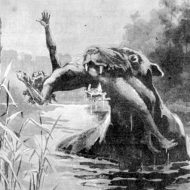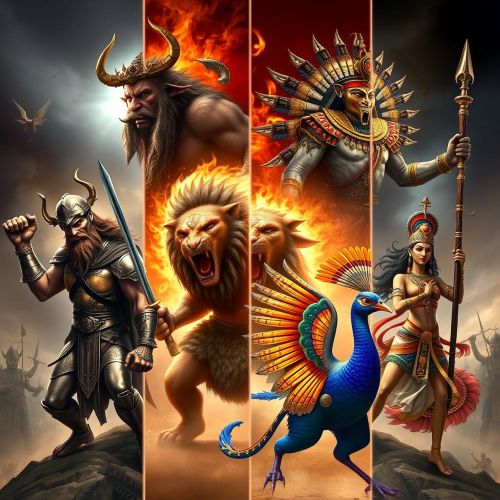Bunyip : The Water Beast
Listen
At a glance
| Description | |
|---|---|
| Origin | Aboriginal Mythology |
| Classification | Hybrids |
| Family Members | N/A |
| Region | Australia |
| Associated With | Marshes, Child Abduction, Hypnotism |
Bunyip
Introduction
The Bunyip is also referred to as the Kianpraty, and it’s a creature of Aboriginal mythology that lives in various areas of Australia, such as creeks, rivers, and swamps. In the Wemba-Wemba language, it’s also called “devil”. Stories about these animals have been told by Aboriginal peoples, and they’ve been known to prey on children. In modern times, there have been many different descriptions of the Bunyip.
It’s believed that the bunyip made booming or roaring noises when it was told to kill people, especially children and women. The origin of this belief could be found in the appearance of seals that were far upstream from their regular course and the booming nose of the bittern marsh bird.
Physical Traits
The Bunyip is a bird-like creature that’s similar to an alligator. Its head and body are similar to that of an emu, and its long bill has a similar serrated appearance to that of a stingray. The Bunyip’s hind legs are incredibly strong, and its fore legs are longer than its body. Natives claim that the Bunyip uses its long arms and legs to kill its prey by hugging it to death. When it’s in the water, it swims like a frog, and when it’s on the shore, it stands up tall which could be around twelve or thirteen feet.
There are many different descriptions of the Bunyip. Some people claim that it has a dog-like face, and it has a horse-like tail, dark fur, a duck-like bill, and a pair of tusks. Others think it looks like a snake with a beard. Although it is hard to tell from the descriptions what the animal looks like due to its varying appearance, all agree that it is an aquatic mammal.
Family
One legend says that a man named Bunyip broke the Rainbow Serpent’s greatest law by eating his totem animal. Banished by the good spirit, Baiame, the man became an evil spirit that lured tribesmen and their livestock into the water so he could eat all of them.
Other Names
Today, Aboriginal Australians use the term bunyip to refer to evil spirits. This translation might not have accurately represented the creature’s role in pre-contact Aboriginal mythology. Some sources also suggest that the bunyip might have been related to the Bunjil, a mythological creature that made all of the animals and humans in the world.
Powers and Abilities
In some Aboriginal bedtime stories, the Bunyip is said to have been known to attack livestock and children when they come close to the water’s edge. According to some Aboriginal cultures, the Bunyip is known to prey on children and women at night. The Bunyip is believed to have supernatural powers. It can alter the water level, cripple victims with its roar, and hypnotize humans to act as its slave.
Modern Day Influence
The bunyip is a core element of most Australian modern day cultures ranging from characters being based on it in books, cartoons, movies and comics. Bunyip sighting tours are also very common in Australia, very similar to the Ninki Nanka sighting tours in Africa. The bunyip tourist attraction at Murray Bridge is a popular stopover for many tourists in Australia.
Related Images
Frequently Asked Questions
What is a bunyip in real life?
There is no real-life equivalent to the bunyip. It is a mythical creature from Australian Aboriginal folklore, often described as a large, water-dwelling creature with a dog-like or humanoid face. The bunyip is a symbol of the unknown and the fear of the wilderness, and its exact appearance and nature vary across different Aboriginal cultures.
What is the myth of the bunyip?
The bunyip is a mythical creature from Australian Aboriginal folklore. It is often described as a large, water-dwelling beast with a dog-like or humanoid face. The bunyip is a symbol of the unknown and the fear of the wilderness.
What is the real name of the bunyip?
There is no “real name” for the bunyip. As a mythical creature, it doesn’t have a specific name beyond “bunyip.” The term “bunyip” is used collectively to refer to various interpretations of this creature across different Aboriginal cultures.
What animal is a bunyip?
The bunyip is not a real animal. It is a mythical creature from Australian Aboriginal folklore, often described as a large, water-dwelling beast with a dog-like or humanoid face. There is no scientific evidence to suggest that such a creature ever existed.
Are bunyips evil?
Bunyip’s evil nature is a complex and debated topic. Some stories portray it as a menacing creature, while others see it as a guardian. The bunyip’s nature often depends on the context of the story and the cultural perspective of the storyteller.






